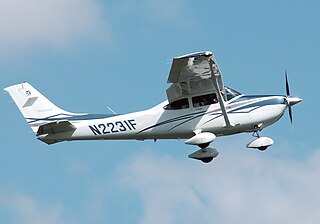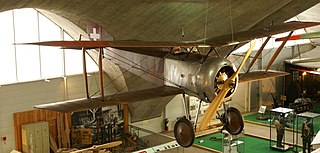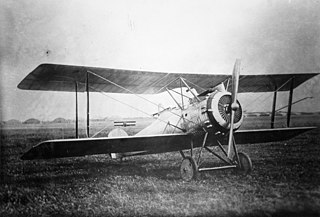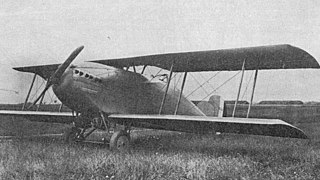| HD.18 | |
|---|---|
 | |
| Role | Colonial police |
| National origin | France |
| Manufacturer | Hanriot |
| First flight | 1921 |
| Number built | 1 |
The Hanriot HD.18 was a three-seat colonial police aircraft built by Hanriot in the early 1920s.
| HD.18 | |
|---|---|
 | |
| Role | Colonial police |
| National origin | France |
| Manufacturer | Hanriot |
| First flight | 1921 |
| Number built | 1 |
The Hanriot HD.18 was a three-seat colonial police aircraft built by Hanriot in the early 1920s.
Data from [1]
General characteristics
Performance

The Cessna 182 Skylane is an American four-seat, single-engined light airplane, built by Cessna of Wichita, Kansas. It has the option of adding two child seats, installed in the baggage area.

The Heinkel He 45 was a light bomber produced in Germany in the early 1930s, one of the first aircraft adopted by the newly formed Luftwaffe. Its appearance was that of a conventional biplane and included seating for pilot and gunner in tandem, open cockpits. Developed in parallel with the He 46, it appeared in 1931 as a general-purpose biplane and was employed mainly as a trainer, but was also used by the Luftwaffe for reconnaissance and light bombing duties. Production of this plane totalled 512 aircraft, including those built under licence by Gotha, Focke-Wulf, and BFW.

The Hanriot HD.1 was a French World War I single-seat fighter aircraft. Rejected for service with French squadrons in favour of the SPAD S.VII, the type was supplied to the Belgian Army′s Aviation Militaire Belge and the Royal Italian Army′s Corpo Aeronautico Militare, with both of which it proved highly successful. Of a total of about 1,200 examples built, 831 were produced by Italian companies under licence.

The Arado S I was a biplane trainer built in Germany in 1925. The first of three prototypes was powered by a Bristol Lucifer radial engine, while the other two Arado S.Ia aircraft were fitted with the Siemens-Halske Sh 12. The Siemens-Halske Sh 11 powered the Arado S III, a virtually identical aircraft of which only a single prototype was constructed and sold to Turkey.

The Hanriot HD.2 was a biplane floatplane fighter aircraft produced in France during the First World War which was used after the war for testing the use of aircraft from warships.

The Hanriot HD.3 C.2 was a two-seat fighter aircraft produced in France during World War I.

The Hanriot HD.14 was a military trainer aircraft produced in large numbers in France during the 1920s. It was a conventional, two-bay biplane with unstaggered wings of equal span. The pilot and instructor sat in tandem, open cockpits, and the fuselage was braced to the lower wing with short struts. The main units of the fixed tailskid undercarriage were divided, each unit carrying two wheels, and early production examples also had anti-noseover skids projecting forwards as well.
The Hanriot HD.17 was a French trainer seaplane of the 1920s. It was essentially a floatplane version of the ubiquitous HD.14 with a revised tail and a more powerful engine. Over 50 examples were operated by the Aéronautique Maritime, of which seven were converted to landplanes. A small number of HD.17s were exported to Estonia and Latvia. Further development resulted in the HD.41H.

The Hanriot H.41 was a military trainer aircraft produced in France in the 1920s. It was a further development in the family of aircraft that had commenced with the HD.14 in 1920, and incorporated a number of design features that had been developed for other members of that family. Like those other aircraft, however, it was a conventional, two-bay biplane with unstaggered wings of equal span.

The Hanriot HD.19 was a military trainer aircraft produced in France in the 1920s. Part of the family of designs that began with the HD.14, it was a two-bay biplane with unstaggered wings of equal span. The pilot and instructor sat in tandem, open cockpits. While the HD.14 and most of its derivatives were powered by rotary or radial engines, the HD.19 had a Hispano-Suiza Vee-8.

The Hanriot HD.28 was a military trainer aircraft developed in France in the 1920s as a modernised version of the HD.14 for export markets. The principal difference between the types was that while the HD.14 had an entirely wooden structure, the HD.28's structure was almost entirely of metal. The landing gear was also of more conventional design, with only one wheel on each main unit, plus small anti-noseover skids. The two tandem cockpits of the HD.14 were replaced by a single, long cockpit in which both pilot and instructor sat.

The Hanriot HD.32 was a military trainer aircraft built in France in the 1920s. Derived from the HD.14 and sharing the same basic configuration as it, the HD.32 was a substantially revised design, with redesigned tailplane, undercarriage, and wings of shorter span. The HD.14's wooden construction was replaced in part with metal structure.

The Lorraine-Hanriot LH.10 was a family of training monoplanes built in France in the early 1930s, the most widely produced and well-known member of which was the LH.16, later known simply as the Hanriot H.16. It was a conventional parasol-wing monoplane with fixed tailskid undercarriage, the main units of which were mounted on outriggers attached to the wing struts. The pilot and instructor sat in tandem open cockpits.

The Hanriot H.43 was a military utility aircraft produced in France in the late 1920s and early 1930s which was primarily used by the Aéronautique Militaire as a trainer. While Hanriot had spent most of the 1920s manufacturing further and further developments of the HD.14 that had flown in 1920, the H.43 was an entirely new design. It was a conventional single-bay biplane with staggered wings of unequal span and a fuselage of fabric-covered metal tube. Accommodation for the pilot and passenger was in tandem, open cockpits and the main units of the fixed, tailskid undercarriage were linked by a cross-axle.

The Hanriot H.170, H.180, and H.190 were a family of light utility aircraft produced in France in the 1930s. All introduced in 1934, they appeared side by side at the Paris Air Show that year, the model numbers distinguishing between versions powered by Salmson, Renault, and Régnier engines respectively.

The Farman NC.470 was a French twin-engined floatplane designed as a crew trainer for the French Navy. It was used in small numbers for both its intended role as a trainer and as a coastal reconnaissance aircraft at the start of World War II.

The Lorraine Hanriot LH.130 is a French racing aircraft designed and built in the early 1930s, to compete in the Coupe Michelin air races.
The Hanriot H.33 was a French biplane 2-seat fighter aircraft built in 1926, derived from the Hanriot H.31. It was not successful and only one prototype was completed.

The Hanriot HD.24 was a two-seat colonial police biplane aircraft built by Hanriot in the early 1920s.
The Hanriot HD.40S was a two-seat medical transport aircraft built in the 1920s, derived from the Hanriot HD.14S.
| Wikimedia Commons has media related to Hanriot HD.18 . |